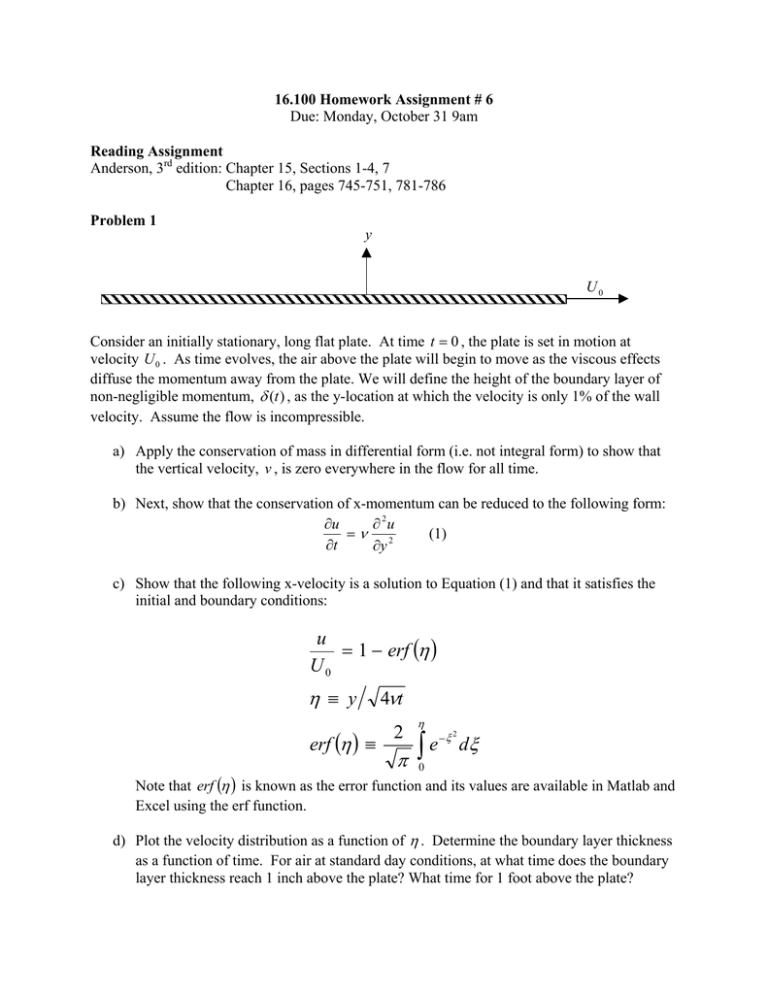Document 13475669
advertisement

16.100 Homework Assignment # 6 Due: Monday, October 31 9am Reading Assignment Anderson, 3rd edition: Chapter 15, Sections 1-4, 7 Chapter 16, pages 745-751, 781-786 Problem 1 y U0 Consider an initially stationary, long flat plate. At time t = 0 , the plate is set in motion at velocity U 0 . As time evolves, the air above the plate will begin to move as the viscous effects diffuse the momentum away from the plate. We will define the height of the boundary layer of non-negligible momentum, δ (t ) , as the y-location at which the velocity is only 1% of the wall velocity. Assume the flow is incompressible. a) Apply the conservation of mass in differential form (i.e. not integral form) to show that the vertical velocity, v , is zero everywhere in the flow for all time. b) Next, show that the conservation of x-momentum can be reduced to the following form: ∂u ∂ 2u (1) =ν 2 ∂t ∂y c) Show that the following x-velocity is a solution to Equation (1) and that it satisfies the initial and boundary conditions: u = 1 − erf (η ) U0 η ≡ y erf (η ) ≡ 4νt 2 π η −ξ ∫ e dξ 2 0 Note that erf (η ) is known as the error function and its values are available in Matlab and Excel using the erf function. d) Plot the velocity distribution as a function of η . Determine the boundary layer thickness as a function of time. For air at standard day conditions, at what time does the boundary layer thickness reach 1 inch above the plate? What time for 1 foot above the plate? e) Determine the skin friction coefficient c f as a function of time where cf = τ wall τ wall = µ ∂u ∂y ρU 02 2 1 y =0 Plot c f as a function of U t / ν . As time proceeds, is the plate easier or harder to keep 2 0 moving at the same velocity? Notice that at t = 0 , the skin friction has some rather large values. Obviously, in a real situation, the friction does not reach these values. What basic part in the specification of the problem is the cause for this? Hint: it is not the infinite length of the plate. Problem 2 Consider the flow between two concentric cylinders as shown below: R1 ω0 ω1 R0 The inner cylinder has radius R0 and rotates at an angular velocity of ω 0 . The outer cylinder has radius R1 and rotates at an angular velocity of ω1 . Assume the fluid between the cylinders has a density ρ and dynamic viscosity of µ . Also, assume that the resulting flow is steady and parallel such that the radial velocity, u r , is equal to zero. a) Using the continuity equation, show that the circumferential velocity, uθ , is independent of θ. b) Using the circumferential momentum equation, and applying boundary conditions, determine the circumferential velocity. c) Without solving directly for the static pressure, use the radial momentum equation to show that the static pressure must increase with increasing radius. d) This type of device is often used to measure the dynamic viscosity of a fluid by measuring the resulting moment acting on the cylinder. Determine the moment acting on the inner cylinder is M . The final result should only depend on µ , R0 , R1 , ω 0 , and ω1 . Incompressible Equations for Cylindrical Coordinates Mass: 1 ∂ (rur ) + 1 ∂ (uθ ) + ∂ (u x ) = 0 r ∂r r ∂θ ∂x Radial Momentum: u Dur 1 2 1 ∂p 2 ∂uθ + ν ∇ 2 ur − r − − uθ = − ρ ∂r Dt r r 2 r 2 ∂θ Circumferential Momentum: Duθ ur uθ 1 ∂p 2 ∂ur uθ + ν ∇ 2 uθ − − − =− Dt r ρr ∂θ r 2 ∂θ r 2 Axial Momentum: Du x 1 ∂p =− + ν ∇2u x Dt ρ ∂x where: ∂ ∂ uθ ∂ ∂ D = + ur + + ux Dt ∂t ∂r r ∂θ ∂x ( ∇2 = ν≡ ) 1 ∂ ∂ 1 ∂2 ∂2 r + + r ∂r ∂r r 2 ∂θ 2 ∂x 2 µ (kinematic viscosity) ρ




